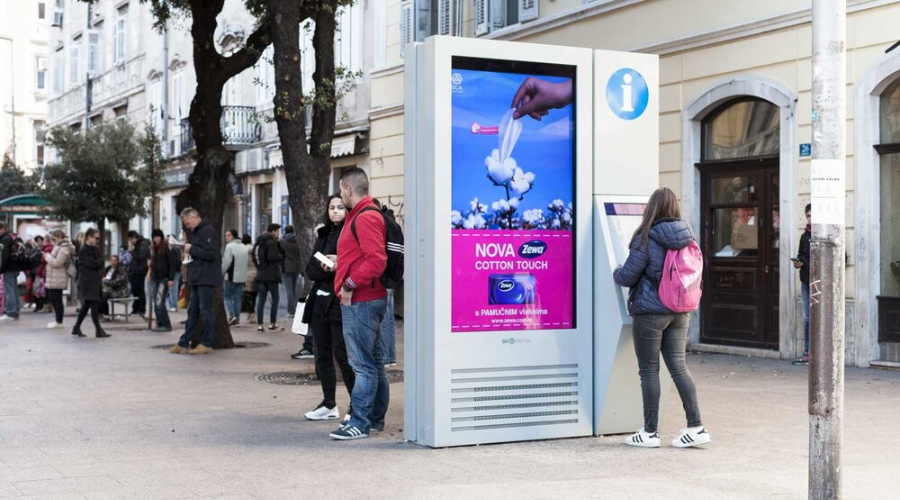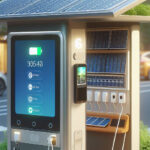In outdoor advertising, the digital era has ushered in a dynamic shift. Traditionally static billboards and signage are now giving way to interactive, vibrant, and attention-grabbing outdoor digital displays.
These high-tech tools are transforming the landscape of outdoor advertising, revolutionizing brand awareness, and offering an unparalleled opportunity to captivate audiences. This article will explore this growing trend and illustrate how outdoor digital displays are becoming an essential component of successful marketing strategies.
The rise of outdoor digital displays
Outdoor digital displays are enjoying a surge in popularity, and there are several compelling reasons why. Advances in technology and a shift in consumer behavior have combined to make digital displays a powerful and increasingly affordable tool for businesses of all sizes.
- Striking visual appeal: The vibrant, high-definition visuals of outdoor digital displays are hard to ignore. They offer a level of clarity and color fidelity that traditional print media simply can’t match. According to a study by Arbitron, 71% of people often look at the messages on roadside billboards, which suggests that outdoor digital displays have an inherent capacity to draw attention.
- Dynamic content: Outdoor digital displays provide the flexibility to change content frequently and without additional costs. This ability to display time-sensitive or targeted messages increases their relevance and engagement potential. The Out of Home Advertising Association of America (OAAA) reports that digital out-of-home (DOOH) media has a 15-50% higher recognition rate than static out-of-home media, demonstrating the effectiveness of dynamic content.
- 24/7 visibility: Unlike other forms of outdoor advertising that rely on external light sources, digital displays are self-illuminating, meaning they’re visible day and night. This continuous exposure significantly boosts the number of impressions they generate.
- Interactivity and engagement: Advanced digital displays can offer interactive experiences, such as touchscreens or augmented reality integrations. These features can significantly enhance audience engagement. A study by Grand View Research indicated that interactive displays market size was valued at USD 14.63 billion in 2020 and is expected to expand at a compound annual growth rate (CAGR) of 8.3% from 2021 to 2028, demonstrating the growing demand for interactive experiences.
- Cost and energy efficiency: While the initial investment in digital signage may be higher than traditional methods, the long-term costs can be lower due to the savings on printing, distribution, and waste disposal. Additionally, newer models of digital displays are becoming more energy-efficient, further reducing operational costs and aligning with the sustainability goals of many modern businesses. Learn about options for financing advertising displays.
The combination of these factors has propelled the adoption of outdoor digital displays across numerous sectors, including retail, hospitality, transportation, and corporate communications. With their visual appeal, dynamic capabilities, and growing affordability, these innovative advertising tools are set to dominate the outdoor advertising landscape for the foreseeable future.
Captivating audiences with dynamic content
One of the significant advantages of outdoor digital displays lies in their ability to present dynamic content. Unlike traditional billboards, these displays can show moving images and videos, making them more engaging and likely to capture the viewer’s attention.
The content can also be changed or updated instantly without any additional cost, allowing advertisers to respond quickly to changing market conditions or customer behaviors.
Moreover, advanced digital displays can provide interactive experiences, offering touchscreen capabilities, augmented reality elements, or real-time data integration. By engaging audiences in this interactive way, brands can create more profound, lasting impressions that can lead to increased brand recall and customer loyalty.
Innovative examples of outdoor digital displays
To truly grasp the potential of outdoor digital displays, we can look at some innovative applications.
For instance, Pepsi Max launched a dynamic digital advertising campaign at a bus stop in London, featuring augmented reality scenarios ranging from a meteor crash to a tiger running loose. This campaign captivated passersby and created significant buzz on social media, illustrating the potential of digital displays to go beyond traditional advertising and create unforgettable brand experiences.
Another excellent example is the McDonald’s “McTrax” campaign in the Netherlands, which turned a large outdoor billboard into an interactive music studio. By using their smartphones, passersby could create their beats and share them on social media. The campaign resulted in high levels of audience engagement and significant online buzz, demonstrating the innovative ways in which brands can leverage outdoor digital displays.

Comparing outdoor digital displays to other advertising methods
Every advertising medium has its strengths and weaknesses, and outdoor digital displays are no exception. Understanding how these displays compare with other advertising methods is crucial for businesses trying to decide where to allocate their marketing budget for maximum brand awareness.
Outdoor digital displays vs traditional billboards
Traditional billboards have been a mainstay of outdoor advertising for decades. However, outdoor digital displays offer significant advantages. As mentioned earlier, the flexibility to change content frequently allows for time-sensitive promotions and targeted messaging.
In contrast, changing the content on a traditional billboard is a more involved process, often requiring physical labor and materials, which could add additional costs. According to a Nielsen study, digital billboards generate high recall for ads and positive consumer attitudes, with 82% of billboard viewers noticing digital billboards both day and night.
Outdoor digital displays vs print media
Print media such as magazines, newspapers, and flyers allow for detailed messaging and a wide distribution. However, the static nature of print media means it lacks the dynamic, attention-grabbing visuals of digital displays. Plus, print media can be easy to ignore or dispose of, whereas a large, vibrant digital display in a high-traffic area is much harder for potential customers to overlook.
Outdoor digital displays vs online advertising
Online advertising has the advantage of detailed targeting, retargeting, and conversion tracking. However, digital displays can complement online strategies by reinforcing the same messaging in the physical world, creating a multi-channel marketing approach. Plus, with ad-blocking technology becoming more prevalent, digital displays can ensure your brand message reaches a wider audience.
Outdoor digital displays vs TV and radio ads
While TV and radio ads can reach a large audience, they’re often more expensive and lack the locality of digital displays. Digital displays, especially when placed strategically, can reach a local audience consistently and generate high local brand recognition.
Outdoor digital displays vs social media advertising
Social media advertising provides vast audience targeting capabilities and instant feedback. Still, algorithms control the visibility of ads on these platforms, and the lifespan of social media ads is generally quite short. Conversely, digital displays ensure visibility and have a much longer lifespan per campaign.
In conclusion, while other advertising methods have their advantages, outdoor digital displays provide a unique combination of advantages – locality, visibility, dynamism, and increasingly interactive capabilities – that make them an effective tool for increasing brand awareness in today’s fast-paced advertising landscape.
Final thoughts and other considerations
Outdoor digital displays are an impactful way to boost brand visibility and create memorable experiences. However, their effectiveness hinges on several factors, including content quality, display location, and the target audience’s nature. Thus, brands should strategically plan their digital display campaigns, ensuring they align with their overall marketing objectives and cater to their target audience’s interests and behaviors.
As technology continues to advance, we can expect to see even more innovative uses of outdoor digital displays. From incorporating artificial intelligence and machine learning to offering personalized experiences based on data analytics, the future of outdoor digital advertising looks bright and promising. Marketers, therefore, need to stay abreast of these developments to effectively leverage these tools and continue revolutionizing brand awareness.
For more information about outdoor digital displays, check out these two articles –
There you will find more knowledge and tips about outdoor digital displays, their advantages, and possibilities.



